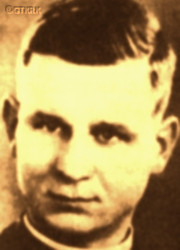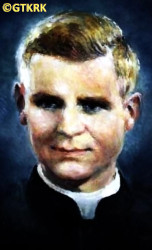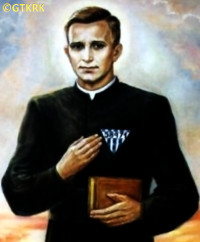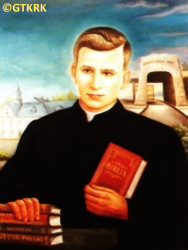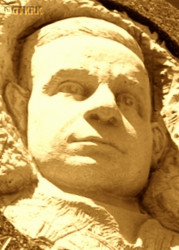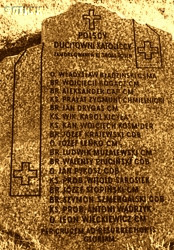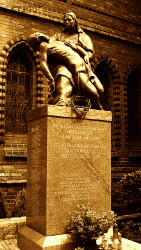Roman Catholic
St Sigismund parish
05-507 Słomczyn
85 Wiślana Str.
Konstancin deanery
Warsaw archdiocese, Poland
full list:
displayClick to display full list

searchClick to search full list by categories
wyświetlKliknij by wyświetlić pełną listę po polsku

szukajKliknij by przeszukać listę wg kategorii po polsku

Martyrology of the clergy — Poland
XX century (1914 – 1989)
personal data
religious status
blessed
surname
BŁĄDZIŃSKI
forename(s)
Vladislav (pl. Władysław)
beatification date
13.06.1999more on
www.swzygmunt.knc.pl
[access: 2013.05.19]

the RC Pope John Paul IImore on
en.wikipedia.org
[access: 2014.09.21]
function
religious cleric
creed
Latin (Roman Catholic) Church RCmore on
en.wikipedia.org
[access: 2014.09.21]
congregation
Congregation of Saint Michael the Archangel (i.e. Michaelite Fathers) CSMAmore on
en.wikipedia.org
[access: 2013.05.19]
(i.e. Michaelites)
date and place
of death
04.1945

KL Bergen‐Belsenconcentration camp
today: n. Bergen, Celle dist., Lower Saxony state, Germany
more on
en.wikipedia.org
[access: 2022.01.09]
alt. dates and places
of death
03.1945, 08.09.1944
KL Groß‐Rosenconcentration camp
today: Rogoźnica, Strzegom gm., Świdnica pov., Lower Silesia voiv., Poland
more on
en.wikipedia.org
[access: 2019.02.02]
details of death
After German and Russian invasion of Poland in 09.1939 and start of the World War II, after start of German occupation, organiser of clandestine teaching and education system in Pawlikowice.
On 21.04.1941 arrested for the first time.
Taken to Pomorska Str. Gestapo HQ in Kraków.
Released.
For the second time arrested on 25.04.1944.
Moved to Montelupich Str. prison in Kraków.
Tortured.
On 25.07.1944 transported to KL Groß‐Rosen German concentration camp where slaved in quarries (according to some sources prior to being sent to KL Groß‐Rosen concentration camp transported to KL Auschwitz concentration camp).
Next, according to German sources, on 25.10.1944 moved to KL Sachsenhausen concentration camp.
Deregistered on 04.11.1944 and few weeks later on 13.11.1944 registered in KL Buchenwald concentration camp.
28.11.1944 transferred to AL Ohrdruf concentration camp.
Finally on 13.03.1945 moved — prob. during mass transfer of c. 4,300 sick inmates — to KL Bergen‐Belsen concentration camp.
Fate thereafter unknown.
Prob. perished in last month prior to liberation of KL Bergen‐Belsen by Allied troop (on 15.04.1945), from hunger, overcrowding, exhaustion, one of c. 35,000 that perished in the camp in 01‐04.1945.
alt. details of death
According to most of the sources prior to 2019 murdered in KL Groß‐Rosen concentration camp — kicked repeatedly and thrown off a cliff.
prisoner camp's numbers
58471 (AL OhrdrufClick to display the description), 106906 (KL BuchenwaldClick to display the description), 108300 (KL SachsenhausenClick to display the description)
cause of death
extermination
perpetrators
Germans
sites and events
KL Bergen‐BelsenClick to display the description, AL OhrdrufClick to display the description, KL BuchenwaldClick to display the description, KL SachsenhausenClick to display the description, KL Groß‐RosenClick to display the description, KL AuschwitzClick to display the description, Cracow (Montelupich)Click to display the description, GeneralgouvernementClick to display the description, Ribbentrop‐MolotovClick to display the description, Pius XI's encyclicalsClick to display the description
date and place
of birth
06.07.1908

Myshlyatychitoday: Shehyni hrom., Yavoriv rai., Lviv obl., Ukraine
more on
uk.wikipedia.org
[access: 2022.08.05]
alt. dates and places
of birth
01.06.1908
parents
BŁĄDZIŃSKI John
🞲 ?, ? — 🕆 ?, ?

MATUSZCZAK Magdalene
🞲 ?, ? — 🕆 ?, ?
religious vows
13.12.1925 (temporary)
13.12.1929 (permanent)
presbyter (holy orders)
ordination
26.06.1938

Przemyśltoday: Przemyśl city pov., Subcarpathia voiv., Poland
more on
en.wikipedia.org
[access: 2021.04.01]
Assumption of the Blessed Virgin Mary and St John the Baptist RC cathedral churchmore on
en.wikipedia.org
[access: 2025.03.14]
positions held
1938 – 1944
friar — Pawlikowicetoday: Wieliczka gm., Wieliczka pov., Lesser Poland voiv., Poland
more on
en.wikipedia.org
[access: 2022.10.02] ⋄ Educational Institute, Michaelites CSMA ⋄ St Michael the Archangel RC chapel ⋄ Wieliczkatoday: Wieliczka gm., Wieliczka pov., Lesser Poland voiv., Poland
more on
en.wikipedia.org
[access: 2021.06.07], St Clement, the Pope and Martyr RC parish — teacher of nature studies, among others
1933 – 1938
student — Przemyśltoday: Przemyśl city pov., Subcarpathia voiv., Poland
more on
en.wikipedia.org
[access: 2021.04.01] ⋄ philosophy and theology, Theological Seminary
c. 1926 – 1933
friar — Pawlikowicetoday: Wieliczka gm., Wieliczka pov., Lesser Poland voiv., Poland
more on
en.wikipedia.org
[access: 2022.10.02] ⋄ Congregation's house, Michaelites CSMA — i.a. student of gymnasium educating candidates for the priesthood
c. 1925 – c. 1926
novitiate — Pawlikowicetoday: Wieliczka gm., Wieliczka pov., Lesser Poland voiv., Poland
more on
en.wikipedia.org
[access: 2022.10.02] ⋄ Congregation's house, Michaelites CSMA
c. 1924 – c. 1925
postulate — Pawlikowicetoday: Wieliczka gm., Wieliczka pov., Lesser Poland voiv., Poland
more on
en.wikipedia.org
[access: 2022.10.02] ⋄ Congregation's house, Michaelites CSMA
from 21.10.1924
friar — Michaelites CSMA
others related
in death
BOGACZClick to display biography Adalbert, CAGClick to display biography Joseph, CAPClick to display biography Alexander, CHMIELNICKIClick to display biography Sigismund, DRYGASClick to display biography Francis, DRYGASClick to display biography John, GRYŹLAKClick to display biography Anthony, JĘDRAClick to display biography Martin, KOŚMIDERClick to display biography Adalbert, KRAJEWSKIClick to display biography Joseph, LEŃKOClick to display biography Joseph, ŁUKOWIAKClick to display biography Anthony, PLUCIŃSKIClick to display biography Valentine, PYKOSZClick to display biography John, SAROSIEKClick to display biography Witold, STOPIŃSKIClick to display biography Joseph, SZMERGALSKIClick to display biography Simon, WĄDRZYKClick to display biography Anthony, WIĘCKIEWICZClick to display biography Leo, ŻUREKClick to display biography Anthony
sites and events
descriptions
KL Bergen‐Belsen: Till 1944 KL Bergen‐Belsen was a prisoner‐of‐war camp, in 1944 was changed into the German Germ. Konzentrationslager (Eng. concentration camp) KL, in 1945 in so‐called „death marches” thousands of prisoners from other concentration camps were transferred, approx. 50,000 of them died in Bergen‐Belsen. When the camp on 15.04.1945 was liberated by the British troops c. 13,000 unburied bodies were found together with c. 60,000 inmates, emaciated, starving, without a food or drink for days, suffering from illness and sickness, mainly typhoid. C. 14,000 of them perished in next two months without regaining strength and health. (more on: pl.wikipedia.orgClick to attempt to display webpage
[access: 2012.11.23], en.wikipedia.orgClick to attempt to display webpage
[access: 2014.03.10])
AL Ohrdruf: German slave labour concentration camp Germ. Zwangsarbeitslager, initially independent but later, as Außenlager S III, a branch of KL Buchenwald concentration camp, near Ohrdruf village in Thuringia in Germany. Prisoners slaved at construction of a railway line leading to an emerging communication and control centre in the basements of Mühlberg castle (unfinished) and at tunnels in the nearby mountains to serve as a crisis center for the train known as the „Führerhauptquartier” (Eng. Führer Command Center). At the end of 1944 c. 10,000 prisoners where held there. Till 03.1945 the number swelled to 20,000 — Russians, Poles, Hungarian Jews, etc. 7,000 perished — part in so‐called „death marches” in 1945 to other camps. Liberated on 04.04.1945 — the first concentration camp liberated by American army. (more on: en.wikipedia.orgClick to attempt to display webpage
[access: 2018.11.18])
KL Buchenwald: In German Germ. Konzentrationslager (Eng. concentration camp) KL Buchenwald concentration camp, founded in 1937 and operational till 1945, Germans held c. 238,380 prisoners and murdered approx. 56,000 of them, among them thousands of Poles. Prisoners were victims of pseudo‐scientific experiments, conducted among others by Behring‐Werke from Marburg and Robert Koch Institute from Berlin companies. They slaved for Gustloff in Weimar and Fritz‐Sauckel companies manufacturing armaments. To support Erla‐Maschinenwerk GmbH in Leipzig, Junkers in Schönebeck (airplanes) and Rautal in Wernigerode Germans organized special sub‐camps. In 1945 there were more than 100 such sub‐camps. Dora concentration camp was initially one of them, as well as KL Ravensbrück sub‐camps (from 08.1944). On 08.04.1945 Polish prisoner, Mr Guido Damazyn, used clandestinely constructed short wave transmitter to sent, together with a Russian prisoner, a short message begging for help. It was received and he got a reply: „KZ Bu. Hold out. Rushing to your aid. Staff of Third Army” (American). Three days later the camp was liberated. (more on: www.buchenwald.deClick to attempt to display webpage
[access: 2013.08.10], en.wikipedia.orgClick to attempt to display webpage
[access: 2013.08.10])
KL Sachsenhausen: In Germ. Konzentrationslager (Eng. concentration camp) KL Sachsenhausen, set up in the former Olympic village in 07.1936, hundreds of Polish priests were held in 1940, before being transported to KL Dachau. Some of them perished in KL Sachsenhausen. Murderous medical experiments on prisoners were carried out in the camp. In 1942‐1944 c. 140 prisoners slaved at manufacturing false British pounds, passports, visas, stamps and other documents. Other prisoners also had to do slave work, for Heinkel aircraft manufacturer, AEG and Siemens among others. On average c. 50,000 prisoners were held at any time. Altogether more than 200,000 inmates were in jailed in KL Sachsenhausen and its branched, out of which tens of thousands perished. Prior to Russian arrival mass evacuation was ordered by the Germans and c. 80,000 prisoners were marched west in so‐called „death marches” to other camps, i.e. KL Mauthausen‐Gusen and KL Bergen‐Belsen. The camp got liberated on 22.04.1945. After end of armed hostilities Germans set up there secret camp for German prisoners and „suspicious” Russian soldiers. (more on: en.wikipedia.orgClick to attempt to display webpage
[access: 2018.11.18])
KL Groß‐Rosen: Groß‐Rosen (today: Rogoźnica) was a German Germ. Konzentrationslager (Eng. concentration camp) KL, founded in the summer of 1940 (first transport of prisoners arrived on 02.08.1940). Initially a branch of KL Sachsenhausen concentration camp. In 1944 became a centre of a network of more than 100 camps. Prisoners were forced to slave at nearby granite quarries, on starvation rations. More than 125,000 prisoners were enslaved — 40,000 victims perished. In 1945 — in „death marches” — Germans dragged through the camp thousands of prisoners from the camp’s in east being one by one overrun by the Russians. The camp itself was captured by the Russians on 14.02.1945. (more on: www.gross-rosen.euClick to attempt to display webpage
[access: 2021.07.18], en.wikipedia.orgClick to attempt to display webpage
[access: 2019.02.02])
KL Auschwitz: German Germ. Konzentrationslager (Eng. concentration camp) KL and Germ. Vernichtungslager (Eng. extermination camp) VL Auschwitz was set up by Germans around 27.01.1940 n. Oświęcim, on the German territory (initially in Germ. Provinz Schlesien — Silesia Province; and from 1941 Germ. Provinz Oberschlesien — Upper Silesia Province). Initially mainly Poles were interned. From 1942 it became the centre for holocaust of European Jews. Part of the KL Auschwitz concentration camps’ complex was Germ. Vernichtungslager (Eng. extermination camp) VL Auschwitz II Birkenau, located not far away from the main camp. There Germans murdered likely in excess of million people, mainly Jews, in gas chambers. In KL Auschwitz alone, the Germans murdered c. 30,000 prisoners by lethal injection. Until 1941, people were killed by intravenous injections of concentrated hydrogen peroxide, ether, hydrogen peroxide, or gasoline. Later, an intracardiac injection was used — with a needle about 10 cm long — of 10‐15 ml of a 30% solution of phenol C6H5OH (acquired from the German concern IG Farben, or more precisely from its subsidiary Bayer, and still used by Bayer AG, among others, for the production of aspirin), which killed within 15 seconds. Altogether In excess of 400 priests and religious went through the KL Auschwitz, c. 40% of which were murdered (mainly Poles). (more on: en.auschwitz.org.plClick to attempt to display webpage
[access: 2012.11.23], www.meczennicy.pelplin.plClick to attempt to display webpage
[access: 2013.07.06])
Cracow (Montelupich): Cracow penal prison, during occupation run by the Germans — from 28.02.1941 by Germ. Geheime Staatspolizei (Eng. Secret State Police, known as Gestapo. In 1940‐1944 Germans jailed there approx. 50,000 prisoners, mainly Poles and Jews. Some of them were transported to KL Auschwitz concentration camp, some were executed. After cease in war effort the prison was used by UB — a Polish unit of Russian NKVD — as a prison for Polish independence resistance fighters, some of which were subsequently sent to prisons and slave labour camps in Russia. (more on: en.wikipedia.orgClick to attempt to display webpage
[access: 2014.10.31])
Generalgouvernement: After the Polish defeat in the 09.1939 campaign, which was the result of the Ribbentrop‐Molotov Pact and constituted the first stage of World War II, and the beginning of German occupation in part of Poland (in the other, eastern part of Poland, the Russian occupation began), the Germans divided the occupied Polish territory into five main regions. In two of them new German provinces were created, two other were incorporated into other provinces. However, the fifth part was treated separately, and in a political sense it was supposed to recreate the German idea from 1915 (during World War I, after the defeat of the Russians in the Battle of Gorlice in 05.1915) of creating a Polish enclave within Germany. Illegal in the sense of international law, i.e. Hague Convention, and public law, managed by the Germans according to separate laws — especially established for the Polish Germ. Untermenschen (Eng. subhumans) — till the Russian offensive in 1945 it constituted part of the Germ. Großdeutschland (Eng. Greater Germany). Till 31.07.1940 formally called Germ. Generalgouvernement für die besetzten polnischen Gebiete (Eng. General Government for the occupied Polish lands) — later simply Germ. Generalgouvernement (Eng. General Governorate), as in the years 1915‐1918. From 07.1941, i.e. after the German attack on 22.06.1941 against the erstwhile ally, the Russians, it also included the Galicia district, i.e. the Polish pre‐war south‐eastern voivodeships. A special criminal law was enacted and applied to Poles and Jews, allowing for the arbitrary administration of the death penalty regardless of the age of the „perpetrator”, and sanctioning the use of collective responsibility. After the end of the military conflict of the World War UU, the government of the Germ. Generalgouvernement was recognized as a criminal organization, and its leader, governor Hans Frank, guilty of war crimes and crimes against humanity and executed. (more on: en.wikipedia.orgClick to attempt to display webpage
[access: 2024.12.13])
Ribbentrop‐Molotov: Genocidal Russian‐German alliance pact between Russian leader Joseph Stalin and German leader Adolf Hitler signed on 23.08.1939 in Moscow by respective foreign ministers, Mr. Vyacheslav Molotov for Russia and Joachim von Ribbentrop for Germany. The pact sanctioned and was the direct cause of joint Russian and German invasion of Poland and the outbreak of the World War II in 09.1939. In a political sense, the pact was an attempt to restore the status quo ante before 1914, with one exception, namely the „commercial” exchange of the so‐called „Kingdom of Poland”, which in 1914 was part of the Russian Empire, fore Eastern Galicia (today's western Ukraine), in 1914 belonging to the Austro‐Hungarian Empire. Galicia, including Lviv, was to be taken over by the Russians, the „Kingdom of Poland” — under the name of the General Governorate — Germany. The resultant „war was one of the greatest calamities and dramas of humanity in history, for two atheistic and anti‐Christian ideologies — national and international socialism — rejected God and His fifth Decalogue commandment: Thou shall not kill!” (Abp Stanislav Gądecki, 01.09.2019). The decisions taken — backed up by the betrayal of the formal allies of Poland, France and Germany, which on 12.09.1939, at a joint conference in Abbeville, decided not to provide aid to attacked Poland and not to take military action against Germany (a clear breach of treaty obligations with Poland) — were on 28.09.1939 slightly altered and made more precise when a treaty on „German‐Russian boundaries and friendship” was agreed by the same murderous signatories. One of its findings was establishment of spheres of influence in Central and Eastern Europe and in consequence IV partition of Poland. In one of its secret annexes agreed, that: „the Signatories will not tolerate on its respective territories any Polish propaganda that affects the territory of the other Side. On their respective territories they will suppress all such propaganda and inform each other of the measures taken to accomplish it”. The agreements resulted in a series of meeting between two genocidal organization representing both sides — German Gestapo and Russian NKVD when coordination of efforts to exterminate Polish intelligentsia and Polish leading classes (in Germany called «Intelligenzaktion», in Russia took the form of Katyń massacres) where discussed. Resulted in deaths of hundreds of thousands of Polish intelligentsia, including thousands of priests presented here, and tens of millions of ordinary people,. The results of this Russian‐German pact lasted till 1989 and are still in evidence even today. (more on: en.wikipedia.orgClick to attempt to display webpage
[access: 2015.09.30])
Pius XI's encyclicals: Facing the creation of two totalitarian systems in Europe, which seemed to compete with each other, though there were more similarities than contradictions between them, Pope Pius XI issued in 03.1937 (within 5 days) two encyclicals. In the „Mit brennender Sorge” (Eng. „With Burning Concern”) published on 14.03.1938, condemned the national socialism prevailing in Germany. The Pope wrote: „Whoever, following the old Germanic‐pre‐Christian beliefs, puts various impersonal fate in the place of a personal God, denies the wisdom of God and Providence […], whoever exalts earthly values: race or nation, or state, or state system, representatives of state power or other fundamental values of human society, […] and makes them the highest standard of all values, including religious ones, and idolizes them, this one […] is far from true faith in God and from a worldview corresponding to such faith”. On 19.03.1937, published „Divini Redemptoris” (Eng. „Divine Redeemer”), in which criticized Russian communism, dialectical materialism and the class struggle theory. The Pope wrote: „Communism deprives man of freedom, and therefore the spiritual basis of all life norms. It deprives the human person of all his dignity and any moral support with which he could resist the onslaught of blind passions […] This is the new gospel that Bolshevik and godless communism preaches as a message of salvation and redemption of humanity”… Pius XI demanded that the established human law be subjected to the natural law of God , recommended the implementation of the ideal of a Christian state and society, and called on Catholics to resist. Two years later, National Socialist Germany and Communist Russia came together and started World War II. (more on: www.vatican.vaClick to attempt to display webpage
[access: 2023.05.28], www.vatican.vaClick to attempt to display webpage
[access: 2023.05.28])
sources
personal:
www.straty.plClick to attempt to display webpage
[access: 2019.04.16], pl.wikipedia.orgClick to attempt to display webpage
[access: 2013.01.13]
bibliographical:
Ms Monika Liebscher, niem. Gedenkstätte und Museum Sachsenhausen (Eng. Memorial and Museum Sachsenhausen), private correspondence, 08.07.2020
„International Tracing Service (ITS), Bad Arolsen, GermanyClick to display source page”, Arolsen Archives
original images:
www.chronologia.plClick to attempt to display webpage
[access: 2013.08.10], wsd.przemyska.plClick to attempt to display webpage
[access: 2019.10.13], pawlikowice.com.plClick to attempt to display webpage
[access: 2019.10.13], mtrojnar.rzeszow.opoka.org.plClick to attempt to display webpage
[access: 2019.10.13], www.michalici.plClick to attempt to display webpage
[access: 2019.10.13], dodek777.flog.plClick to attempt to display webpage
[access: 2016.03.14], img.iap.plClick to attempt to display webpage
[access: 2021.12.19], www.szczecin.plClick to attempt to display webpage
[access: 2014.09.21]
LETTER to CUSTODIAN/ADMINISTRATOR
If you have an Email client on your communicator/computer — such as Mozilla Thunderbird, Windows Mail or Microsoft Outlook, described at WikipediaPatrz:
en.wikipedia.org, among others — try the link below, please:
LETTER to CUSTODIAN/ADMINISTRATORClick and try to call your own Email client
If however you do not run such a client or the above link is not active please send an email to the Custodian/Administrator using your account — in your customary email/correspondence engine — at the following address:

giving the following as the subject:
MARTYROLOGY: BŁĄDZIŃSKI Vladislav
To return to the biography press below:
 Click to return to biography
Click to return to biography








